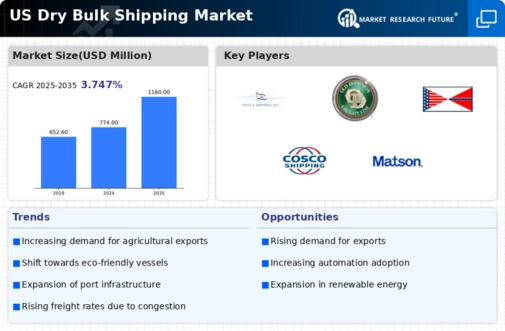Shifts in Trade Patterns
The dry bulk-shipping market is influenced by shifts in trade patterns, particularly as the US engages in new trade agreements and partnerships. Changes in tariffs and trade policies can significantly affect the flow of bulk commodities. For instance, the recent trade agreements with various countries may open new markets for US agricultural products, leading to increased shipping volumes. In 2025, it is anticipated that exports of grains could rise by 10%, directly impacting the dry bulk-shipping market. Additionally, the diversification of supply chains may prompt companies to seek alternative shipping routes, further altering demand dynamics. As these trade patterns evolve, the dry bulk-shipping market must adapt to capitalize on emerging opportunities while navigating potential challenges associated with geopolitical shifts.
Regulatory Changes and Compliance
The dry bulk-shipping market is significantly impacted by evolving regulatory frameworks aimed at enhancing environmental sustainability and safety standards. In recent years, the US has implemented stricter regulations regarding emissions and waste management for shipping vessels. Compliance with these regulations often necessitates investments in cleaner technologies and operational practices. For instance, the introduction of the IMO 2020 sulfur cap has compelled shipping companies to adapt, which may increase operational costs. However, these changes also present opportunities for the dry bulk-shipping market to innovate and differentiate services. Companies that proactively embrace compliance measures may gain a competitive edge, potentially attracting clients who prioritize sustainability. As regulations continue to evolve, the dry bulk-shipping market must remain agile to navigate these challenges while capitalizing on the associated opportunities.
Increased Demand for Raw Materials
The dry bulk-shipping market experiences heightened demand for raw materials, driven by various sectors such as construction, agriculture, and manufacturing. As the US economy continues to expand, the need for commodities like iron ore, coal, and grains surges. In 2025, the demand for iron ore alone is projected to increase by approximately 5%, which directly influences shipping volumes. This trend indicates that the dry bulk-shipping market is likely to benefit from increased cargo loads, thereby enhancing shipping rates and overall profitability. Furthermore, the construction sector's growth, fueled by infrastructure projects, further amplifies the need for bulk shipping services. Consequently, the dry bulk-shipping market is poised to capitalize on this rising demand, potentially leading to a more robust shipping environment in the coming years.
Infrastructure Development and Upgrades
Infrastructure development plays a crucial role in shaping the dry bulk-shipping market. The US government has prioritized investments in port facilities and transportation networks to enhance efficiency and capacity. In 2025, the allocation of federal funds for port upgrades is expected to exceed $2 billion, aimed at modernizing terminals and improving logistics. These enhancements are likely to facilitate smoother operations, reduce turnaround times, and ultimately lower shipping costs. As ports become more capable of handling larger vessels, the dry bulk-shipping market stands to benefit from increased throughput and reduced congestion. This infrastructure investment not only supports the current demand but also positions the industry for future growth, as it can accommodate larger cargo volumes and more diverse shipping routes.
Technological Integration and Automation
The integration of advanced technologies and automation is transforming the dry bulk-shipping market. Innovations such as digital platforms for logistics management and automated cargo handling systems are becoming increasingly prevalent. These technologies enhance operational efficiency, reduce human error, and lower costs. In 2025, it is projected that the adoption of automation in shipping operations could lead to a 15% reduction in operational costs for companies. Furthermore, the use of data analytics allows for better decision-making regarding routing and scheduling, optimizing shipping processes. As the dry bulk-shipping market embraces these technological advancements, it is likely to see improved service delivery and customer satisfaction. The ongoing trend towards digitalization may also attract new entrants to the market, fostering competition and innovation.
















Leave a Comment